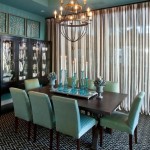How To Decorate A Victorian House
Decorating a Victorian house presents a unique opportunity to blend historical charm with modern sensibilities. This style, popular from the mid-to-late 19th century, is characterized by ornate details, rich colors, and a layered, maximalist aesthetic. Understanding these core elements is crucial for achieving an authentic yet livable Victorian-inspired interior.
Embrace Rich and Dramatic Colors
Victorian color palettes moved away from the lighter, pastel tones of earlier periods and embraced deeper, more dramatic hues. Deep reds, greens, blues, and browns were popular choices, often used in combination with gold accents. These rich colors were used on walls, woodwork, and upholstery, creating a warm and inviting atmosphere. Consider incorporating jewel tones like ruby red, emerald green, sapphire blue, or amethyst purple. Don't be afraid to use these colors on both walls and furniture to create a cohesive and impactful space.
Incorporate Ornate Patterns and Textures
Victorian design celebrated intricate patterns and textures. Damask, floral prints, and paisley were commonly used in fabrics for upholstery, drapery, and wallpaper. These patterns can be incorporated into a modern Victorian interior through accent pillows, throws, and strategically placed wallpaper. Textured fabrics like velvet, silk, and brocade add depth and richness to the space. Consider using textured wallpaper on a feature wall or incorporating patterned rugs to ground the room.
Highlight Architectural Details
Victorian homes are often characterized by distinctive architectural features, such as high ceilings, intricate moldings, stained-glass windows, and ornate fireplaces. These details should be highlighted and celebrated rather than hidden. Restoring original features where possible and using paint colors that accentuate the woodwork can enhance the Victorian character of the room. Consider using a contrasting paint color for the trim to make these details stand out. If your home lacks original features, consider adding period-appropriate molding or ceiling medallions.
Introduce Period-Appropriate Furniture
Furnishing a Victorian-inspired space involves incorporating pieces that reflect the style's opulence and craftsmanship. Look for furniture made from dark wood like mahogany or walnut, often featuring intricate carvings and decorative details. Classic Victorian furniture pieces include chaise lounges, tufted ottomans, and button-backed armchairs. While sourcing authentic antique pieces can be rewarding, reproductions and pieces inspired by the Victorian era can also be incorporated to achieve the desired look. Don't be afraid to mix antique pieces with more modern furniture for an updated take on the style.
Layer Lighting and Textiles
Layering is a key element of Victorian design. Multiple light sources, such as chandeliers, table lamps, and wall sconces, create a warm and inviting ambiance. Layering textiles, such as rugs, curtains, and throws, adds depth and texture to the space. Consider using heavy drapes in rich fabrics and layering them with sheer lace curtains for a truly Victorian feel. Incorporating a variety of textures and patterns in your textiles can also enhance the layered look.
Accessorize with Antiques and Decorative Objects
Accessories play a significant role in completing the Victorian look. Antique clocks, ornate mirrors, framed artwork, and decorative china can be used to add character and personality to the space. Consider incorporating items like vintage books, porcelain figurines, or antique silver pieces to enhance the authentic feel. Grouping similar items together on shelves or in display cabinets can create visual interest and showcase your collections.
Balance Opulence with Functionality
While Victorian design is known for its opulence, it's important to strike a balance with functionality. Avoid overcrowding the space with too much furniture or accessories. Focus on creating a space that is both visually appealing and comfortable to live in. Choose furniture pieces that are both beautiful and functional, and arrange them in a way that allows for easy movement and conversation. Consider incorporating modern conveniences while maintaining the Victorian aesthetic. For example, you could conceal modern technology within antique-style cabinets or integrate updated lighting fixtures that complement the overall design.
:max_bytes(150000):strip_icc()/ScreenShot2021-08-18at3.46.48PM-0881e8625a754c1a94a611f3e74a6226.png?strip=all)
27 Modern Victorian Decorating Ideas That Aren T Stuffy
:max_bytes(150000):strip_icc()/alaina-kaczmarski-home-living-1-9b10209fb438487789b81418ed595c2c.jpg?strip=all)
How To Do Victorian Interior Decor The Sophisticated Way

5 Modern Decorating Ideas From A Renovated Victorian House Goodhomes

Victorian Interior Design Style History And How To Create A Modern Decorator New Jersey

Modern Victorian Decorating Ideas Cb2 Idea Central

9 Best Victorian Interior Design Ideas To Beautify Your Home Foyr

Modern Victorian Homes Decor Ideas Gray Living Room Design

Feast For The Senses 25 Vivacious Victorian Living Rooms Decoist

Small Victorian Terraced House Interior Design Ideas Soho Blog

Victorian Interior Design Get The Look National Museums Liverpool







